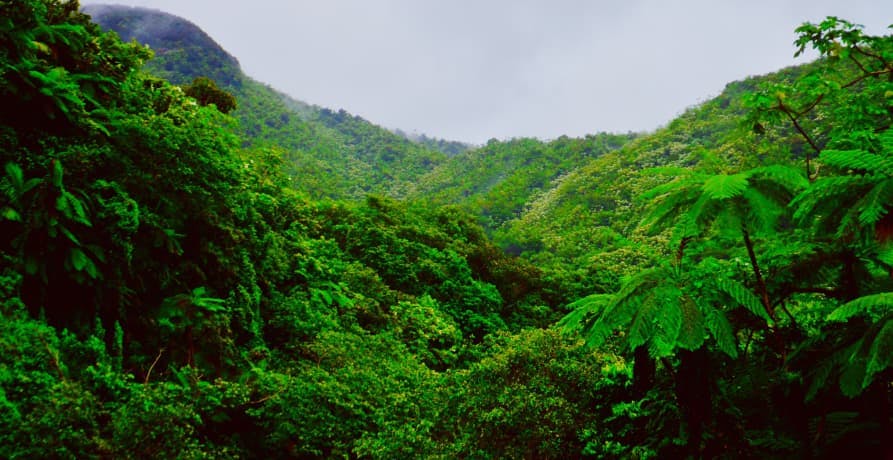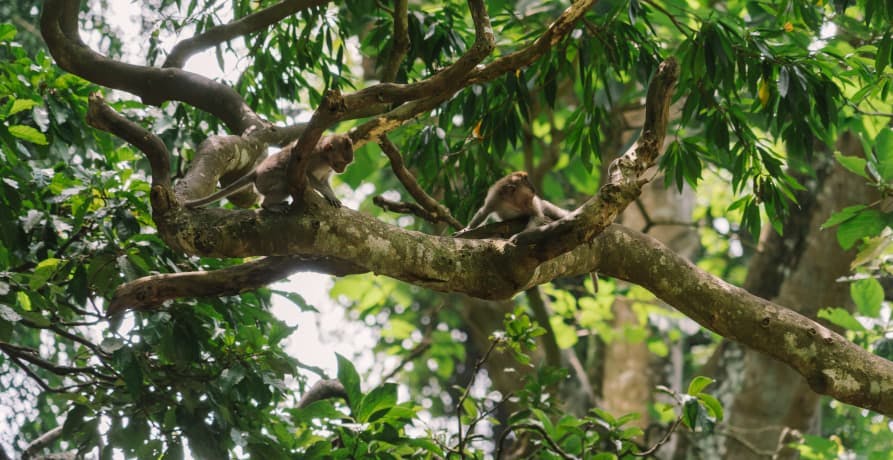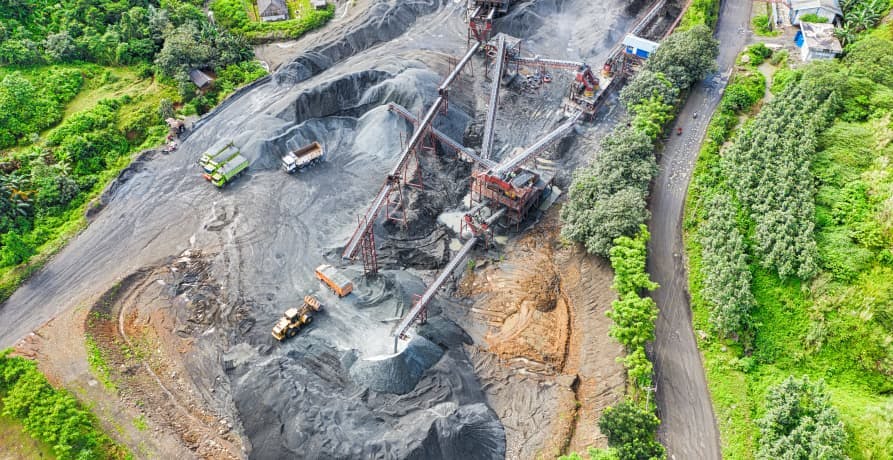ESG / CSR
Industries
The Complex Role of the Amazon Rainforest



The Amazon rainforest was once called the lungs of the Earth, however, deforestation and over-exploitation mean that scientists are now worried that the rainforest has become a carbon source instead of a carbon sink.
Years of unabated development and deforestation have damaged the Amazon rainforest and destroyed invaluable natural habitats. The impacts of these harmful human activities are far-reaching and profound.
👉 In this article we'll explore the importance of the Amazon rainforest, the threats it now faces, and what can be done to reverse the damage it's sustained.
The Importance of the Amazon Rainforest
The importance of the Amazon rainforest cannot be overstated. Covering over 2.5 million square miles and spanning nine countries - Brazil, Peru, Colombia, Venezuela, Ecuador, Bolivia, Guyana, Suriname, and the overseas territory of French Guiana - it is the world's largest tropical rainforest. This vast ecosystem, which stretches from the Atlantic Ocean and includes the Amazon River Basin and the Amazon Forest, is home to 10% of the planet's known biodiversity and contributes 15 to 16% of the world's total river discharge into the ocean.
The Amazon is an area of outstanding natural value and an important tool in the fight against climate change. Let's take a closer look at some of the functions it plays, and the value that it brings:
Carbon Sink
The Amazon rainforest has often been referred to as the "lungs of the planet". This is because the rainforest plays a crucial role in the global carbon cycle by drawing in carbon dioxide and expelling oxygen. However, recent scientific studies suggest that the Amazon could become a carbon source if decisive action is not taken to protect this invaluable tropical rainforest. This potential shift underscores the urgency of preserving the Amazon to maintain its critical function in carbon sequestration.
What is a Carbon Sink?
A carbon sink is any system that absorbs more carbon dioxide (CO2) from the atmosphere than it releases. The world's largest natural carbon sinks include oceans, forests, plants, and soil. Among these, tropical forests like the Amazon rainforest stand out due to their immense size and dense vegetation, which collectively absorb significant amounts of CO2.
How the Amazon Functions as a Carbon Sink
The Amazon rainforest region functions as a carbon sink through the process of photosynthesis. During photosynthesis, trees and other vegetation absorb CO2 from the atmosphere and use it to produce energy, storing the carbon in their roots, branches, leaves, and trunks. This process not only removes CO2 from the atmosphere but also helps to stabilize the global climate by reducing the greenhouse effect.
The Role of Carbon Sinks in Tackling Climate Change
Carbon sinks are essential for mitigating climate change and preventing further global warming. By absorbing excess carbon emissions through carbon sequestration, they prevent the levels of atmospheric CO2 from rising even further. This is crucial because elevated CO2 levels contribute to the greenhouse effect, leading to global temperature increases, extreme weather events, and disruptions in natural ecosystems.
Water Cycle
Rainforests such as the Amazon play a crucial role in the Earth's water cycle, contributing significantly to both regional and global climate regulation.
The water cycle, also known as the hydrologic or hydrological cycle, describes the continuous movement of water within the Earth and its atmosphere. This complex system involves several key processes: condensation, precipitation, infiltration, runoff, and evapotranspiration. The Amazon rainforest, in particular, enhances this cycle by adding vast amounts of water to the atmosphere through evapotranspiration. During photosynthesis, the plants and trees release water vapor, which is absorbed into the atmosphere. This moisture aids in the formation of rain clouds, which eventually release water back into the rainforest as rainfall.
In the Amazon rainforest, an impressive 50 to 80% of moisture remains within the ecosystem's water cycle. This retention of moisture is critical because, when these forests are cut down, the atmosphere absorbs less water, leading to decreased rainfall and sometimes severe droughts.
The Amazon's impact extends beyond local weather patterns. The rainforest releases approximately 20 billion tonnes of water into the atmosphere every single day, and this moisture travels globally, influencing various weather systems. As a result, the Amazon can affect the agricultural output of countries thousands of miles away, demonstrating its global significance. By sustaining the delicate balance of these cycles, the Amazon rainforest supports ecosystems and human activities worldwide, underlining the importance of its preservation for both regional stability and global climate health.

Biodiversity
The Amazon rainforest is incredibly biodiverse, home to at least 10% of the world's known species. This means that one in ten species on Earth can be found within the Amazon rainforest!
Not only does the Amazon contain 10% of the world's species, but it also houses 370 different types of reptiles, over 3,000 freshwater fish species in its rivers, and more than 40,000 different plant species.
These impressive numbers continue to grow as we discover more and more species. Between 1999 and 2009, 1,200 new species of plants and animals were discovered in the Amazon rainforest.
Moreover, many species of animals, flora, and fauna are endemic to the Amazon. Unique creatures like the Amazon river dolphin, the giant otter, the bald uakari (a type of primate), the gray woolly monkey, the golden lion tamarin, and the pygmy marmoset can only be found here.
These creatures play vital roles in the complex ecosystem of the Amazon rainforest, each contributing to the health and sustainability of the forest. For instance:
- Pollinators: Species such as bees, butterflies, and bats pollinate diverse plant life, ensuring the reproduction of a vast array of plants, which in turn provide food and shelter for countless other species.
- Seed Dispersers: Animals like toucans, monkeys, and agoutis play a crucial role in seed dispersal. By consuming fruits and then excreting the seeds far from the parent plants, they help maintain plant diversity and promote forest regeneration.
- Predators: Apex predators such as jaguars and harpy eagles regulate the populations of other animals, maintaining a balance that prevents any one species from dominating and disrupting the ecosystem.
- Decomposers: Insects, fungi, and bacteria break down dead organic matter, recycling nutrients back into the soil. This decomposition process enriches the soil, fostering plant growth and supporting the entire ecosystem.
To illustrate this complexity, consider the interactions between different species in the Amazon: When a fruit bat eats a piece of fruit, it not only gets nourishment but also aids in seed dispersal. The seeds that are dropped or excreted grow into new plants, which are then pollinated by bees. These plants provide food for herbivores, which in turn are preyed upon by carnivores like jaguars. When these animals die, decomposers break down their bodies, returning nutrients to the soil and completing the cycle.
This intricate web of interactions ensures that the Amazon rainforest remains a vibrant and resilient ecosystem, capable of supporting its incredible biodiversity. By maintaining this delicate balance, the forest continues to thrive, playing a crucial role in global ecological health.
Medicine and Research
The Amazon rainforest, home to over 40,000 different plant species, holds enormous potential for medicine and research. Remarkably, 25% of all Western drugs are derived from rainforest plants, and given that only about 5% of the Amazon's plants have been studied, the potential for discovering new medicines and treatments is huge.
Here are some notable examples of the incredible medicinal uses of Amazon flora and fauna:
| Substance | Origin | Medical Use |
|---|---|---|
| Quinine | Originally discovered by the Quechua tribe in Peru and Bolivia, derived from the bark of the cinchona tree | Plays a crucial role in the treatment of malaria |
| Madagascan Periwinkle | This beautiful pink flower | Used to develop drugs that help slow down the spread of cancer |
| ACE Inhibitors (Angiotensin Converting Enzyme) | Developed from a compound found in the venom of a tropical viper native to the Amazon | Used worldwide to control hypertension |
| Curare | Derived from various plants in the Amazon | Developed into a muscle relaxant used during surgeries |
| Copaiba | Extracted from the copaiba tree | Used for its anti-inflammatory and antimicrobial properties |
| Lapacho (Pau d'Arco) | Derived from the inner bark of the lapacho tree | Has antimicrobial, antifungal, and antiviral properties, used to treat infections and boost the immune system |
| Pilocarpine | Obtained from the jaborandi plant | Used to treat glaucoma and dry mouth caused by radiation therapy |
| Sangre de Drago (Dragon's Blood) | Sap of the Dragon's Blood tree | Used for its wound-healing and anti-inflammatory properties, treating ulcers, diarrhea, and skin conditions |
These examples barely scratch the surface of the medicinal potential provided by the Amazon's natural resources. The untapped wealth of plant and animal species in the rainforest holds promise for countless new medical discoveries, highlighting the critical need for its preservation and continued research.

Why is the Amazon Rainforest Under Threat?
In recent years, the Amazon rainforest has been in the headlines for alarming reasons. Wildfires have ravaged vast areas of this biodiverse forest, killing countless animals and destroying crucial vegetation.
Large swathes of forest have been flattened and cleared to make way for seemingly unchecked development. Industrial-scale farming, logging, and mining activities are placing immense pressure on the rainforest, harming biodiversity, destroying habitats, and threatening local communities.
In this section, we'll take a closer look at some of the major threats the Amazon is currently facing:
Development
Development in the Amazon poses a significant threat, driving many harmful activities that result in extensive forest clearing and ecosystem disruption. Large-scale clearance for soybean production, livestock, mining, and drilling operations is devastating the rainforest. Brazil in particular has seen vast tracts of its rainforest converted into soybean fields to meet global demand, disrupting ecosystems, displacing wildlife, and destroying habitats.
Mining is another critical threat. The pursuit of resources like gold, iron ore, and minerals essential for technology and electric vehicle batteries, such as lithium, nickel, and copper, has led to significant forest clearance. This mining activity not only contributes to deforestation but also causes long-term environmental damage.
While the environmental damage is evident, the motivations behind government support for development are complex. Many South American countries are developing nations striving to grow their economies and improve living standards. Promoting industry and infrastructure development is often seen as a pathway to economic growth, despite the high environmental cost.
It's also important to note that much of the development is in response to growing international demand for raw goods. Beef is being consumed around the world, and soy is now an important ingredient in a huge number of food products. Ironically, the push for environmentally friendly technology, such as electric vehicles, also contributes to the rainforest's destruction due to the need for rare earth minerals, which are a crucial component of lithium batteries.
Illegal Clearing
Illegal clearing of the Amazon rainforest is an ongoing issue that significantly contributes to deforestation and environmental degradation. This illegal activity involves the unauthorized removal of forested areas for agricultural expansion, logging, mining, and land speculation. Despite governmental efforts to curb these practices, illegal clearing continues to thrive, driven by high economic incentives and often facilitated by corruption and weak enforcement of environmental laws.
Illegal logging is a major component of this problem, with vast quantities of valuable timber harvested and sold on the black market. These operations not only destroy large swathes of forest but also undermine legal logging activities and sustainable forest management practices. The environmental impact is severe, leading to loss of biodiversity, disruption of ecosystems, and increased carbon emissions. Additionally, illegal clearing often involves the use of fire to clear land quickly, which can lead to uncontrollable wildfires that further devastate the rainforest.
Efforts to combat illegal clearing have been met with some success, however, the vast and remote nature of the Amazon, combined with limited resources and the influence of powerful agribusiness and mining interests, makes comprehensive enforcement challenging.

Deforestation
Deforestation is linked to all of the previous issues. Development and illegal activities are a primary driver of deforestation, and in turn, deforestation makes forest fires even more of a risk - it's a vicious cycle.
Deforestation is arguably the single biggest threat to the Amazon rainforest, with extensive and highly damaging effects. This issue is particularly severe in Brazil, which is home to 60% of the Amazon. Under President Jair Bolsonaro's administration, deforestation rates surged to a 12-year high, driven by policies that favored agricultural expansion, logging, and mining at the expense of environmental protection.
The Bolsonaro Era
During Bolsonaro's tenure, deforestation in Brazil escalated dramatically. His administration weakened environmental regulations, reduced funding for environmental agencies, and encouraged development activities within the Amazon. This led to widespread illegal logging, land grabbing, and increased clearing of forested areas for agriculture and infrastructure projects. The result was devastating: vast tracts of rainforest were destroyed, biodiversity was lost, and the Amazon's critical role in regulating the global climate was severely undermined.
A New Hope: President Lula's Pledge
The election of President Luiz Inácio Lula da Silva brought renewed hope for the Amazon. Lula pledged to end deforestation by 2030 and restore the rainforest. His commitment was evident during his speech at the COP27 climate summit in 2022, where he vowed to chase down climate criminals and restore environmental protections. In 2023, data from Brazil's national space agency, Inpe, showed a nearly 50% reduction in deforestation rates compared to the previous year, marking the lowest recorded deforestation rate in the last five years. This significant decrease, from 10,278 square kilometers in 2022 to 5,153 square kilometers in 2023, indicates that Lula's policies and increased enforcement efforts are beginning to take effect.
The Broader Amazon Region
Deforestation is not limited to Brazil. Other countries that share the Amazon rainforest, including Peru, Colombia, Venezuela, Ecuador, Bolivia, Guyana, Suriname, and French Guiana, also face deforestation challenges. Each of these countries grapples with illegal logging, mining, and agricultural expansion, which contribute to the overall degradation of the Amazon. For example, in Peru, illegal gold mining has led to devastating forest loss and mercury pollution, while in Colombia, cattle ranching and coca cultivation are primary drivers of deforestation.
Let's take a closer look at some of the major impacts of deforestation:
Loss of Biodiversity
Clearing forests and vegetation for development destroys not only plants but also habitats crucial for countless species. The Amazon is home to a vast array of unique species, and habitat destruction leads to significant loss of biodiversity. Species that are endemic to specific geographical areas are especially vulnerable, and their extinction becomes a real possibility.

Degradation of Ecosystems
The development of cattle ranches, mining facilities, and infrastructure such as roads and highways fragment the rainforest, significantly impacting fragile ecosystems. Ecosystems interact in complex ways that are often difficult to predict, and fragmenting these areas of biodiversity disrupts their natural balance, leading to degradation and harm to the species residing within them.

Disruption to the Water Cycle
Deforestation interrupts the water cycle. By clearing trees and plants, we reduce the amount of water that can be absorbed into the atmosphere. This can severely impact rainfall within the Amazon, increasing the risk of drought and forest fires and contributing to global warming through the release of carbon dioxide. The impacts extend beyond the immediate region, as the Amazon's water cycle also influences weather systems globally. Decreased rainfall in southern South America, a region with extensive agricultural land, may seriously affect agricultural output and food supply.

Decreased Ability to Absorb Carbon Dioxide
The Amazon rainforest has traditionally functioned as a significant carbon sink, with its trees, vegetation, and soil absorbing carbon dioxide from the atmosphere, helping to mitigate climate change. However, deforestation reduces the Amazon's capacity to absorb carbon dioxide, limiting its function as a carbon sink. This reduction exacerbates the effects of global warming.

Forest Fires
Forest fires are a significant and growing threat to the Amazon rainforest, exacerbated by both human activities and natural climatic conditions. Deforestation plays a crucial role in making the Amazon more susceptible to fires. A study found that around 43% of forest fires in the Brazilian Amazon since 2019 can be linked to deforestation. By removing vast tracts of trees, deforestation not only destroys habitats but also disrupts the rainforest's natural humidity, making the environment drier and more flammable. This sets the stage for forest fires to ignite and spread more easily.
The 2023 Fire Surge
In 2023, Brazil's Amazon experienced a dramatic 152% increase in fire outbreaks in primary (old-growth) forests, rising from 13,477 fires in 2022 to 34,012 in 2023. This surge in fires is largely attributed to severe drought conditions which have been exacerbated by a combination of factors including deforestation, climate change, and natural phenomena such as El Niño, which intensified dry conditions already aggravated by high global temperatures.
Impact on Regions and Indigenous Communities
The state of Roraima in Brazil has been particularly hard hit, experiencing record-breaking fires in 2024. In February alone, Roraima registered an all-time high of 2,057 fire outbreaks, and by March, 14 of its 15 municipalities had declared emergencies due to unprecedented fires. Nearly a quarter of these fires occurred in Indigenous areas, affecting at least 13 territories, including the Yanomami, which is already dealing with a major humanitarian health crisis.
Other Amazonian countries such as Guyana, Suriname, and Venezuela also recorded record-high numbers of fires in early 2024.
Environmental and Health Consequences
The fires have far-reaching environmental impacts. For example, in October 2023, the state of Pará in Brazil registered 11,378 fires, an increase of 52% from the previous year. These fires scorched vast stretches of protected rainforest, including the Tapajós National Forest and the Tapajós-Arapiuns Extractive Reserve, causing significant ecological damage and sending plumes of smoke over hundreds of kilometers. Similarly, the state of Amazonas recorded 3,858 fires in October 2023, doubling the number from the previous year and leading to severe air quality issues in cities like Manaus, which had one of the worst air quality levels in the world on October 11, 2023.
The combination of drought and fires has led to almost complete drying up of rivers, as seen in the Porto Praia community of the Kokama Indigenous people in Amazonas state. This isolation hampers the community's ability to collect supplies and navigate, highlighting the broader humanitarian impacts of these environmental crises.
Long-term Ecosystem Degradation
Fires in mature forests not only cause immediate damage but also have long-term consequences. Burnt forests become more flammable and prone to future fires, leading to persistent ecosystem shifts. The Amazon's ability to create a moist sub-canopy microclimate, which helps contain and recycle moisture, is compromised when mature, old-growth forests are lost. This weakening resilience makes the environment drier and more vulnerable to fires.
Repeated burning also alters the forest composition, with fire-tolerant species becoming more dominant, resulting in forests that are poorer in biodiversity. If invasive exotic grasses penetrate these burnt areas, the ecosystem becomes even more vulnerable, pushing the Amazon closer to a large-scale ecological tipping point.
Carbon Emissions
Forest fires significantly impact the global carbon cycle. In February 2024, wildfires in Brazil and Venezuela alone emitted more than 9 million tons of carbon, the most ever recorded for the month. This is equivalent to the annual carbon emissions of Honduras. Fires not only reduce the Amazon's capacity to absorb carbon due to the destruction of older trees but also release massive stores of carbon into the atmosphere, exacerbating global warming.
From Carbon Sink to Carbon Source
In 2021, alarming studies confirmed for the first time that parts of the Amazon rainforest were emitting more carbon dioxide than they were able to absorb. This shift from a carbon sink to a carbon source in certain areas is a dire warning about the impacts of human activities on this vital ecosystem. The Amazon, previously a crucial buffer against climate change, is now showing signs of contributing to its acceleration.
The Role of Deforestation and Forest Fires
The primary drivers of this change are deforestation and uncontrolled forest fires. During the rule of Brazil's previous president, Jair Bolsonaro, policies that encouraged land clearing for beef and soy production led to a significant increase in forest fires. These fires produce about 1.5 billion tonnes of CO2 annually, while the forest only absorbs 0.5 billion tonnes, leaving a net emission of 1 billion tonnes of CO2 each year - equivalent to the annual emissions of Japan, the world's fifth-biggest polluter. This transformation is particularly alarming because it suggests that specific regions of the Amazon are no longer mitigating climate change but exacerbating it.
Climate Change and Reduced Carbon Absorption
In addition to fires, deforestation leads to higher temperatures and reduced rainfall, which further diminish the Amazon's ability to absorb CO2. A nine-year study published in Nature revealed that the eastern and southeastern regions of the Amazon, which have experienced significant deforestation, now emit more CO2 than they absorb. These areas, representing about 20% of the Amazon basin, have lost 30% of their rainforest, leading to a 25% reduction in precipitation and a temperature increase of at least 2.7 degrees Fahrenheit during the dry season. This drier, hotter environment makes the forest more vulnerable to fires and reduces its capacity to act as a carbon sink.
Regional Differences in Carbon Balance
The study highlighted that while the eastern Amazon has become a net emitter of CO2, the wetter and more intact western and central Amazon still maintain a balance between absorption and emissions. The eastern region, particularly the southeast, is severely affected by deforestation and climate stress, turning it into a carbon source. In contrast, the central and western regions, with less than 20% of forest cover removed, have so far avoided this fate, indicating a stark regional difference within the Amazon basin.
Long-term Implications
The implications of this shift are profound. The Amazon basin, covering 2.8 million square miles, contains over half of the world's remaining tropical rainforest and stores approximately 123 billion tons of carbon. The degradation of even part of this crucial ecosystem not only releases massive amounts of CO2 into the atmosphere but also weakens the forest's ability to moderate global climate. If the current trends continue, more regions of the Amazon could follow the same path, further accelerating climate change.
Urgency of Action
The study’s findings highlight the critical need for immediate action to address deforestation and climate change. Protecting the Amazon requires robust policies to halt illegal clearing and fires, support for sustainable land management practices, and international cooperation to reduce global demand for products driving deforestation. The future of the Amazon - and its role in global climate regulation - depends on the ability to implement effective conservation strategies and reduce fossil fuel emissions.
What Can Be Done to Save the Amazon?
The good news is that it is possible to reverse some of the damage to the Amazon rainforest and ensure that it absorbs more carbon dioxide than it produces. However, this is neither an easy nor a quick fix.
Limit Deforestation and Control Fires
The most crucial step in reversing the damage is to drastically limit deforestation and prevent uncontrolled forest fires. Achieving this requires strong political support from the governments of the countries that share the Amazon rainforest. This includes enforcing existing laws and implementing new regulations to protect the forest.
In Brazil, for example, farmers who start forest fires often go unpunished, and political leaders have historically turned a blind eye to these practices. Policies have sometimes even facilitated the clearing of the Amazon for development. Fortunately, with the end of President Bolsonaro's tenure and the election of President Luiz Inácio Lula da Silva, there is renewed hope. Lula has vowed to protect the Amazon and end deforestation. However, achieving these goals will require not only political will but also practical enforcement measures and international cooperation.
Investment and International Cooperation
Preserving the Amazon rainforest will also require substantial investment from both national governments and international funding sources. However, the cost of inaction is far greater, given the Amazon's crucial role in global climate regulation and biodiversity preservation. International cooperation and support can help provide the necessary resources and political will to implement effective conservation strategies.
International agreements and funding mechanisms, such as the Green Climate Fund, can play a pivotal role in supporting conservation efforts. Countries that import products like beef and soy from the Amazon region must also take responsibility by ensuring that their supply chains are free from deforestation.
Sustainable Development Practices
Promoting sustainable development practices is another critical aspect of saving the Amazon. Encouraging agroforestry, which integrates trees and shrubs into agricultural landscapes, can provide economic benefits to local communities while preserving forest cover. Eco-tourism and non-timber forest products, such as nuts, fruits, and medicinal plants, can also provide sustainable income sources that do not involve clearing the forest.
Raising Awareness and Advocacy
Public awareness and advocacy are powerful tools in the fight to save the Amazon. Educating people about the importance of the Amazon and the threats it faces can help build a global movement for its protection. Advocacy groups and NGOs play a crucial role in lobbying for stronger environmental policies and holding governments and corporations accountable for their actions.
The Important Role of Indigenous Communities
Indigenous communities have called the Amazon rainforest home for thousands of years, accumulating invaluable knowledge and helping to protect and preserve these vital forests. Their deep connection to the land has enabled them to develop sustainable practices that maintain the health of the rainforest ecosystem.
Over the years, the arrival of colonists and an increasing number of settlers have threatened their communities and ways of life. The encroachment of external forces has often led to displacement, loss of land, and cultural erosion. Today, most indigenous communities in the Amazon live in reserves, known as "resguardos." In Brazil, indigenous communities have actively participated in the demarcation of their land, resulting in areas known as "indigenous lands."
Key to Conservation
Many believe that Indigenous communities are crucial to the conservation of the Amazon rainforest. They possess the knowledge and wisdom required to sustainably provide for their communities while protecting the future of the forest. Their traditional practices and deep respect for nature ensure they live in harmony with the environment. Unlike other groups, indigenous communities are not depleting the Amazon's resources; instead, they are often the ones preserving them.
Amazonians have been modifying their environment for thousands of years, but they have done so in ways that avoid over-exploitation. They have carefully practiced and developed farming techniques that minimize environmental damage in the long run. Agroforestry, rotational farming, and selective harvesting are some of the methods they use to maintain ecological balance. These sustainable practices not only support their livelihoods but also contribute to the overall health of the rainforest.
The Amazon’s Future
The future of the Amazon rainforest now hangs in the balance. Once called the lungs of the earth, some studies suggest that the rainforest has actually become a carbon source instead of a carbon sink.
However, all is not lost, the Amazon rainforest can be saved, provided the political will and funding are put in place to protect this incredible natural resource.
How Greenly Can Help Companies Become More Green
Greenly supports companies in their efforts to reduce emissions and embrace greener practices. Our suite of services includes:
- Carbon Management: Track Scope 1, 2, and 3 emissions using advanced technology for a complete view of your greenhouse gas footprint. Our platform offers detailed insights into your emissions sources, enabling you to identify and target areas for improvement effectively.
- Custom Action Plans: Develop tailored strategies with our climate experts, focusing on key areas for improvement and implementing effective changes. Our team will work with you to create a roadmap to sustainability that aligns with your business goals and regulatory requirements.
- Supply Chain Decarbonisation: Engage suppliers and transition to low-carbon options, achieving greater transparency and effectively managing Scope 3 emissions. Sustainable sourcing initiatives help build greener partnerships and reduce emissions throughout your supply chain, ensuring a holistic approach to sustainability.
- Intuitive and Seamless Platform: Our user-friendly platform simplifies the process of calculating and monitoring your carbon footprint. It helps your business manage its environmental impact effortlessly, meet ESG goals, and enhance sustainability. With real-time data and analytics, you can track your progress and make informed decisions to improve your carbon management practices.
With Greenly’s help, your business can significantly reduce its environmental impact and achieve lasting sustainability. Our expertise and cutting-edge technology ensure that you have the tools and knowledge needed to make meaningful progress toward your sustainability goals.
Contact Greenly today to start leading the way in sustainability and build a greener future for your company. Whether you are just beginning your journey or looking to enhance your existing efforts, Greenly is here to support you every step of the way.











